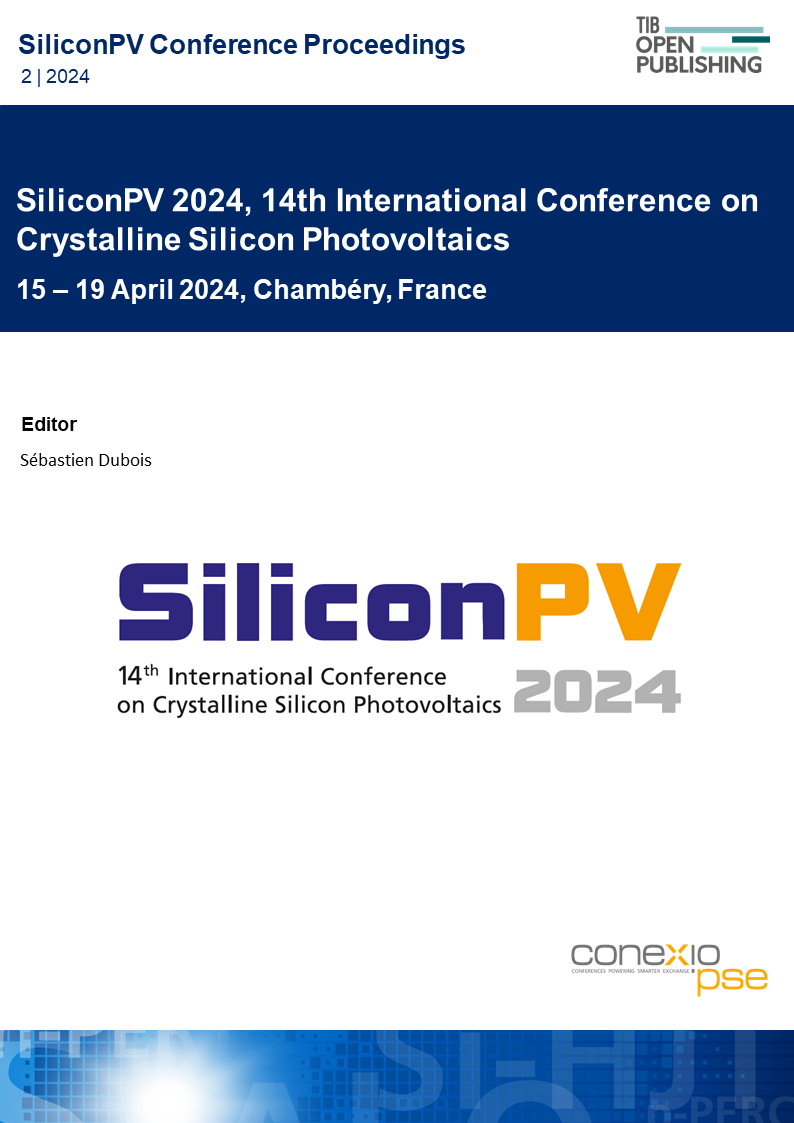Understanding the Effect of Grown-in Defects in Silicon on Solar Cell Efficiency
DOI:
https://doi.org/10.52825/siliconpv.v2i.1294Keywords:
Silicon Solar Cell, Defect Density, Light Scattering Tomography (LST), Efficiency, Fill Factor (FF)Abstract
Improving the efficiency of silicon-based solar cells is imperative to maximise harnessing of solar power. The current improvements in efficiency were attained by better manufacturing techniques and purer materials. There is however indirect evidence that the so-called agglomerated grown-in defects in silicon have a direct impact on cell efficiency and if this is the case, the efficiency could be improved by crystal engineering. This study focuses on understanding the defect generation and growth mechanisms in commercial silicon crystals and their impact on cell efficiency. Silicon wafers from different parts of the crystal having a range of oxygen and dopant concentrations and growth profiles, were investigated. These crystals were characterized using various tools and techniques such as Infrared Light Scattering Tomography (LST) to measure the defect density, and Fourier Transform Infrared Spectroscopy (FTIR) to measure the oxygen concentration. Solar cells were then fabricated out of these wafers to measure the performance of the devices. An understanding of why and how such defects impact the yield of different silicon wafers will lead to a thorough understanding of the relationship between the defect types, size and densities and cell efficiency. Moreover, this study will also shed light on the development of crystal recipes or after-crystal procedures to eliminate or minimize these effects on solar cell performance.
Downloads
References
[1] J. Knobloch, S. W. Glunz, D. Biro, W. Warta, E. Schaffer, and W. Wettling, “Solar cells with efficiencies above 21% processed from Czochralski grown silicon,” Conference Record of the IEEE Photovoltaic Specialists Conference, pp. 405–408, 1996, doi: 10.1109/PVSC.1996.564029.
[2] X. Yu and D. Yang, “Growth of crystalline silicon for solar cells: Czochralski si,” Handbook of Photovoltaic Silicon, pp. 129–174, Jan. 2019, doi: 10.1007/978-3-662-56472-1_12.
[3] X. Zhang et al., “Mass production of crystalline silicon solar cells with polysilicon-based passivating contacts: An industrial perspective,” Progress in Photovoltaics: Research and Applications, vol. 31, no. 4, pp. 369–379, Apr. 2023, doi: 10.1002/PIP.3618.
[4] W. Shockley and H. J. Queisser, “Detailed Balance Limit of Efficiency of p‐n Junction Solar Cells,” J Appl Phys, vol. 32, no. 3, pp. 510–519, Mar. 1961, doi: 10.1063/1.1736034.
[5] W. Shen, Y. Zhao, and F. Liu, “Highlights of mainstream solar cell efficiencies in 2023,” Frontiers in Energy, pp. 1–8, Feb. 2024, doi: 10.1007/S11708-024-0937-5.
[6] A. Richter et al., “Design rules for high-efficiency both-sides-contacted silicon solar cells with balanced charge carrier transport and recombination losses,” Nature Energy 2021 6:4, vol. 6, no. 4, pp. 429–438, Apr. 2021, doi: 10.1038/s41560-021-00805-w.
[7] R. Falster, V. V. Voronkov, J. C. Holzer, S. Markgraf, S. McQuaid, and L. Mule’ Stagno, “Intrinsic point defects and reactions in the growth of large silicon crystals,” p. 1638, 1998, Accessed: Jan. 08, 2024. [Online]. Available: https://www.um.edu.mt/library/oar/handle/123456789/110811
[8] F. Korsós et al., “Efficiency limiting crystal defects in monocrystalline silicon and their characterization in production,” Solar Energy Materials and Solar Cells, vol. 186, pp. 217–226, Nov. 2018, doi: 10.1016/J.SOLMAT.2018.06.030.
[9] L. Chen et al., “Effect of oxygen precipitation on the performance of Czochralski silicon solar cells,” Solar Energy Materials and Solar Cells, vol. 95, no. 11, pp. 3148–3151, Nov. 2011, doi: 10.1016/J.SOLMAT.2011.06.044.
[10] B. Lim, K. Bothe, and J. Schmidt, “Impact of oxygen on the permanent deactivation of boron-oxygen-related recombination centers in crystalline silicon,” J Appl Phys, vol. 107, no. 12, Jun. 2010, doi: 10.1063/1.3431359.
[11] Q. Wang et al., “Impact of boron doping on electrical performance and efficiency of n-TOPCon solar cell,” Solar Energy, vol. 227, pp. 273–291, Oct. 2021, doi: 10.1016/J.SOLENER.2021.08.075.
[12] V. A. Trukhanov, V. V. Bruevich, and D. Y. Paraschuk, “Effect of doping on performance of organic solar cells,” Phys Rev B Condens Matter Mater Phys, vol. 84, no. 20, p. 205318, Nov. 2011, doi: 10.1103/PHYSREVB.84.205318/FIGURES/21/MEDIUM.
[13] A. Borghesi, B. Pivac, A. Sassella, and A. Stella, “Oxygen precipitation in silicon,” J Appl Phys, vol. 77, no. 9, pp. 4169–4244, May 1995, doi: 10.1063/1.359479.
[14] W. Bergholz, “Chapter 12 Grown-in and Process-Induced Defects,” Semiconductors and Semimetals, vol. 42, no. C, pp. 513–575, Jan. 1994, doi: 10.1016/S0080-8784(08)60255-0.
[15] L. Chen et al., “Effect of oxygen precipitation on the performance of Czochralski silicon solar cells,” Solar Energy Materials and Solar Cells, vol. 95, no. 11, pp. 3148–3151, Nov. 2011, doi: 10.1016/J.SOLMAT.2011.06.044.
[16] R. Kvande, Ø. Mjøs, and B. Ryningen, “Growth rate and impurity distribution in multicrystalline silicon for solar cells,” Materials Science and Engineering: A, vol. 413–414, pp. 545–549, Dec. 2005, doi: 10.1016/J.MSEA.2005.09.035.
[17] H. T. Nguyen and D. Macdonald, “On the composition of luminescence spectra from heavily doped p-type silicon under low and high excitation,” J Lumin, vol. 181, pp. 223–229, Jan. 2017, doi: 10.1016/j.jlumin.2016.08.036.
[18] D. Macdonaldd and A. Cuevas, “Reduced Fill Factors in Multicrystalline Silicon Solar Cells Due to Injection! level Dependent Bulk Recombination Lifetimes,” 1999, doi: 10.1002/1099-159X(200007/08)8:4<363::AID-PIP328>3.0.CO;2-Y.
[19] J. Ellis, S. Heinemeyer, K. A. Olive, G. Weiglein, “Phenomenological indications of the scale of supersymmetry”. Journal of High Energy Physics. vol. 2006. JHEP05(2006). doi: 10.1088/1126-6708/2006/05/005
[20] K. Sakai, “Detection limit for defect density by light scattering tomography,” Japanese Journal of Applied Physics, Part 1: Regular Papers and Short Notes and Review Papers, vol. 45, no. 9 A, pp. 7181–7183, Sep. 2006, doi: 10.1143/JJAP.45.7181.
Published
How to Cite
Conference Proceedings Volume
Section
License
Copyright (c) 2024 Jinta Mathew, Bulent Arikan, Sercan Aslan, Ryan Bugeja, Davide La Fata, Jessica Magro, Vahdet Özyahni, Selin Seyrek, Nurhayat Yildirim, Daniele Zingariello, Marija Demicoli, Raşit Turan, Luciano Mule' Stagno

This work is licensed under a Creative Commons Attribution 4.0 International License.
Accepted 2024-06-18
Published 2025-01-22
